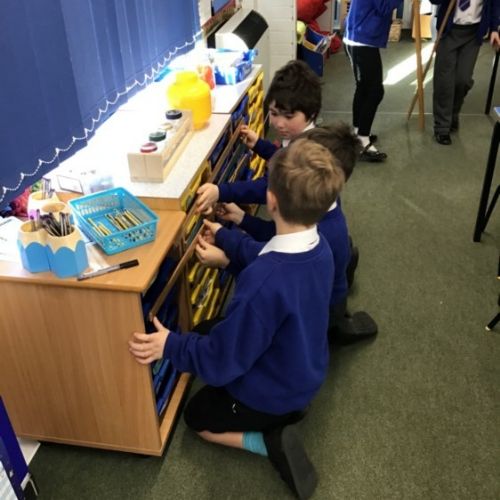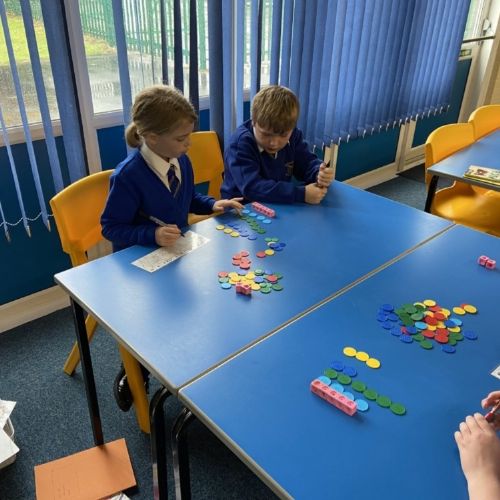Maths
We teach Maths Mastery skills to our children using 'Maths No Problem. Maths No Problem incorporates the use of resources, problem solving and group work. There is a sharp focus on teaching maths for mastery and the series is designed to improve the maths confidence of both learners and teachers. Watch the videos below which will introduce you to the teaching methods we will be using.
Intent
At Tattershall Primary School we recognise that Mathematics is essential to everyday life, critical to science, technology and engineering, and necessary for financial literacy and most forms of employment. We aim to provide a high-quality mathematics education with a mastery approach so that all children:
- become fluent in the fundamentals of mathematics;
- reason mathematically;
- can solve problems by applying their mathematics.
(National Curriculum 2014)
At Tattershall Primary School every child has an equal entitlement to a broad and balanced Maths curriculum. Individual needs are continuously assessed and catered for so that every child can work in an environment where they feel valued and understood and where they can truly know that they are all capable Mathematicians. We intend to foster a love of Maths and a confidence in each child that will give them the enthusiasm, resilience and skills to extend their learning beyond the classroom and into later life.
Implementation
At Tattershall Primary School we use Maths No Problem in EYFS and years 1-6. As part of this scheme, teachers will ensure the following for every mathematics lesson.
- Precise questioning to test conceptual and procedural knowledge;
- How and when manipulatives will be used within in each lesson to scaffold difficult tasks;
- Tasks and challenge questions to challenge pupils to apply and deepen their learning and mathematical reasoning.
We are confident that this Mastery based approach enthuses children about Maths and ensures they can master Mathematical skills and concepts which enable them to continue learning as they progress through school and beyond. Maths is studied daily, and each lesson starts with the ‘in focus’ activity. This will generally lead to a class or group discussion about how to solve the question and why they used a particular strategy. Children will then work on a guided practice activity, where they will work either individually, with a learning partner or with an adult. At this point the children will work at their own pace.
Once the Guided practice task is completed the children will move on to independently completing the Maths No Problem workbook activity. When this is completed, the children will record/explain their solution to the ‘in focus’ task in their maths journal, with extension work also available for those children who require further challenge. At all points in the lesson all children will be working on the same topic. The teacher and other adults will be offering individual or group support as necessary and there will be regular plenaries throughout the lesson. All lessons will be conducted in an environment of challenge, pace and a sense that all can and will achieve their best. Lessons that do not follow the Math No Problem format will generally follow a similar structure. The structure of specific lessons may be adapted where necessary, to suit the topic and to vary the approach to aid understanding.
Opportunities are also taken for pre and post learning. Children are taken in groups to review a topic or prepare for lessons to come. Through continued assessment and discussions with all adults and children concerned, misunderstanding or gaps in learning are regularly addressed on an individual, group or class basis as necessary.
Correct mathematical vocabulary is an essential part of each lesson and the children need to understand this within the area they are studying and they also need to be able to make rich connections across other areas within this subject. Each lesson provides children with the opportunity to reason through their ideas, use their mathematical language to explore a line of enquiry and problem solve routine and non-routine problems.
There are countless opportunities for children to encounter Maths throughout the EYFS (both inside and outside) – through both planned activities and the self-selection of easily accessible quality maths resources. Whenever possible children’s interests are used to support delivering the mathematics curriculum.
Maths progression
At Tattershall Primary School, we follow the Maths No Problem programme which aligns with the 2014 National Curriculum. The programme ensures progression of each topic throughout each year to embed a deep knowledge and understanding of maths. For each topic, children are given a knowledge organiser which summarises the key facts and essential knowledge that children need to help embed their learning.
|
Year |
Theme |
What we want our children to know |
|---|---|---|
EYFS |
Autumn
Spring
Summer
|
|
Year 1 |
Autumn
Spring
Summer
|
|
Year 2 |
Autumn
Spring
Summer
|
|
Year 3 |
Autumn
Spring
Summer
|
|
Year 4 |
Autumn
Spring
Summer
|
|
Year 5 |
Autumn
Spring
Summer
|
|
Year 6 |
Autumn
Spring
Summer
|

.jpeg)


